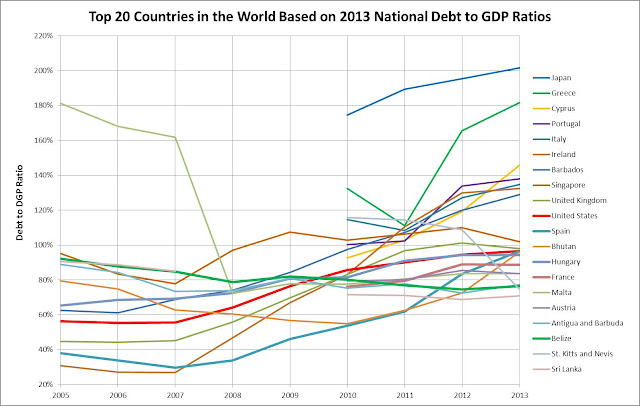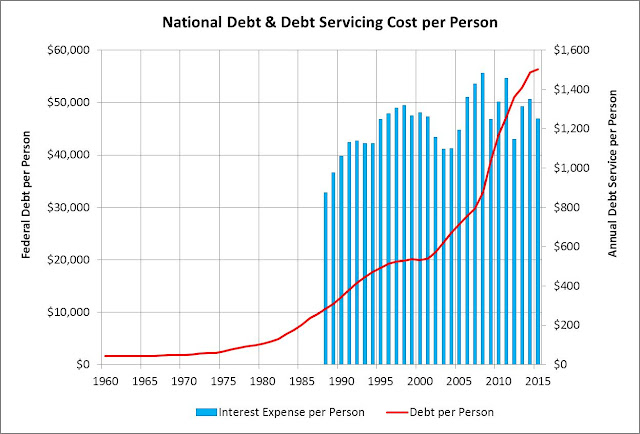United States Sovereign Debt
The Status
and Implications of United States Government Debt
January 14, 2017
Brad Bradshaw
President, Velerity
brad@velerity.com
A. United States Sovereign Debt Is Approaching $20 Trillion
United States government debt is approaching $20
trillion and more than doubled between 2005 and 2015, rising from $7.8 trillion
in 2005 to $18.1 trillion in 2015. This
rate of growth in our national debt is a concern. Is the United States becoming too indebted as
a nation? Will the burden of our
national debt subsume our economic vitality and future well-being? Is our government at risk of defaulting on
its national debt?
For nearly one-hundred years, as shown in Figure 1 below,
our national debt has moved roughly in lock step with GDP, albeit with a few exceptions. First, as seen in 1944, the government issued
significant debt as part of the war effort, with our national debt rising to
about 120% of annual GDP. From 1944 to
the mid-seventies, national debt remained in a relatively slow growth regime. Starting in the early 1980’s, however, debt
as a proportion of GDP began to rise, going from about 30% of GDP in 1982 to
about 65% of GDP in 1995. In the 1990’s,
government debt hit a relatively stable period, with reduced growth rates,
until 2002, at which time we see another uptick in the growth of debt,
accelerating for about a decade.
Figure 1 – United States Sovereign Debt
The 2007 recession created an extraordinary economic challenge,
with fears of total collapse of the global economy. Accordingly, the United States federal
government, peering down into an economic abyss, decided to significantly
increase liquidity in the market, through several means. Regardless of the specific mechanisms, the U.S.
treasury loaded up on a significant amount of debt, increasing the federal debt
79% over a 5 year period from 2007 to 2013, with the national debt increasing from
$9.0 trillion at the end of 2007 to $16.1 trillion by the end of 2012. This acceleration in the growth and
stratospheric level of our federal debt is concerning.
B. Our Growing Federal Debt has Placed the United States in Perhaps an Unwelcome Pantheon of Debtor Nations
Figure 2 below provides some comparative context for the
United States’ level of debt. Based on 2013
data from the World Bank, the United States is 10th in the world
when compared to all other countries in terms of its level of sovereign debt
compared to GDP. The unwelcome pantheon of
debtor nations includes Greece, Portugal, Ireland and Spain, countries which
have faced significant challenges due to their debt being downgraded, and their
capacity to sustain borrowing being limited.
These countries were forced to significantly curtail government
expenditures, further extending and deepening economic downturns and creating
social chaos. Greece’s ongoing economic,
social and political strife provides an example of how poorly handled
(exploding) sovereign debt can impact a country and its people.
Figure 2 – Comparison of Debt to GDP for Selected Countries
The United States is also in the company of several large, established
economies, including United Kingdom, Italy, France and Austria, with equally large
and dangerous levels of sovereign debt. This
begs the question as to whether or not this level of debt for the United States
is sustainable, much less prudent and warranted.
C. Low Interest Rates Are Keeping Debt Servicing Costs Low, Will This Advantage Last?
To bring the impact of our national debt down to a personal
level, the amount of indebtedness per person has risen from about $20,000 per
person in 2000 to $55,000 per person in 2015, nearly tripling over 15
years. The cost of this indebtedness per
person, however, has benefitted tremendously from the on-going low levels of interest
rates, with the interest expense per person keeping within a tight range in the
past 25 years, ranging from about $1,100 per person per year to $1,400 per
person per year, as seen in the blue bars in Figure 3 below.
Figure 3 – National Debt Per Person and Debt Servicing Per
Person
It is extremely unlikely that interest rates will remain
this low going forward. The implied interest
rate associated with the United States’ debt servicing costs was a mere 2.23%
in 2015, the lowest it has likely ever been, and the lowest level for that past
thirty years of data evaluated for this analysis. This has been an extraordinary gift for the
citizens of the United States as well as the federal budget. Unfortunately, we know it will not last. We are currently entering a period of
tightening, with the Federal Reserve Bank already increasing interest rates twice
in the past twelve months, with further tightening expected in the next few
years.
D. What Really Is the Impact of Federal Debt?
Our federal debt is a function of the federal deficit, occurring
when spending exceeds revenues. The
federal government continues the policy allowing spending to exceed revenues,
and accordingly place the cost of running the government in the current year on
backs of future tax payers. Every
taxpayer in the country has a future and ongoing financial obligation to pay
for today’s government expenditures for many years into the future.
There are classic risks associated with this policy of
letting current deficits continue, placing future obligations on taxpayers, and
letting the debt rise to beyond currently stratospheric levels. The most significant is that interest rates will
rise, and the financial burden on each taxpayer may well double within the next
five years. This financial obligation
will crowd out other federal budget priorities, taking a progressively larger
share of the federal budget.
The debt obligation will also limit the ability of the
federal government to address future economic downturns, limiting our ability
to call upon fiscal and monetary policy.
There may be a point in time when the high level of debt and associated
obligations negatively impact the government’s debt ratings and borrowing
capacity.
At a more fundamental level, however, federal debt is a shift
in wealth from taxpayers to investors. As
a result of federal debt, taxpayers lose control over their own financial well-being,
and have less disposable income to spend or invest.
At the end of the day, the federal government is asking
taxpayers to invest in government operations, with the implied promise that, from
a social perspective, these investments will generate greater value for society
going forward than the associated cost of those investments. The unfortunate reality is that the
government’s expenditures at the margin are not likely to generate greater
value than the cost of those investments.
This places a drag on the economy, a parasitic burden from a value
generating perspective.
This investment drag on the economy is also additionally burdened
by the reduction in the velocity of dollars in the economy caused by the
inequity and imbalance associated with taking money out of the hands of
taxpayers and placing it in the hands of bond investors.
E. Conclusion – Where does this Leave Us?
The big picture for the United States associated with this
high level of debt is troubling. If we
face another economic downturn, we may not be able to overcome the economic challenge
with limited access to fiscal or monetary tools. We may be entering a new economic phase, similar
to Japan, in the clutches of a struggling economy for decades, with no apparent
solution.
Historically, a growing economy coupled with an increase in inflation
has been the approach to bring a country’s indebtedness in line with its
economy. The 1990’s was a time when our federal
government was able to bring our expenditures in line with tax receipts. It is going to be a fundamental imperative
that we return to a period of reducing government expenditures and/or raise
taxes to address this imbalance and step back from the debt precipice.
Additionally, it would be useful for our federal government
to make expenditure decisions that explicitly take into consideration the long
term value creation or destruction associated with budget line items, to shift
the mix of government expenditures, at the margin, to have a greater positive impact
in terms of value creation and on our future well-being.
Our federal government should also implement tax and expenditure
policies that encourage greater investments across our economy in value
creating investments and activities, and away from parasitic and value
destroying investments. The absence of
an explicit understanding and of having a policy of encouraging value creating
investments will result in a long and unsatisfying economic malaise and economic
hopelessness for the United States.




1 comment:
the last paragraph in your blog says it all. Using the tax code more creatively we can start rewarding work more (for excample by lowering the payroll tax) and penalizing consumption in the form of a consumption tax (other countries call it a value added tax). The entire world has a VAT but not the U.S. This creates a gaping hole in our economy through which artificially cheap goods from low wage countries seep into the country. We get job insecurity for the masses in exchange for cheap stuff from abroad - A Faustian bargain if there ever was one.
Post a Comment